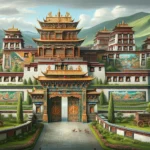A Warm Welcome in Menshi Township
Upon reaching Menshi Township in Gar County, Ngari Prefecture, perched at an impressive 4430 meters above sea level, we found ourselves in a cozy town nestled along the G219 highway. It’s a popular rest stop for heavy trucks and travelers alike. Our lunch stop was a charming Northeastern dumpling restaurant, where we enjoyed a hearty meal. Interestingly, in Tibet, essentials like rice, dumplings, and noodles are cooked in a pressure cooker to ensure they’re perfectly done, given the high altitude. Remember, boiling water here is cooler, around 70~80℃, so if you’re cautious about water quality, bottled water is the way to go.
Stepping Back in Time at Yongdrung Rinchen Cave
The Yongdrung Rinchen cave is a significant piece of Tibetan history, deeply rooted in the Bon Religion and the ancient culture of Zhangzhung. This site offers a unique glimpse into Tibet’s spiritual past.
Journey to Shiquanhe Town and Beyond
Traveling west from Menshi, the road leads straight to Shiquanhe Town, the administrative heart of the Ali region. Our adventure took us off the beaten path from G219, following the Xiangquan River to Chulong village. The journey is facilitated by a smooth, newly asphalted road, promising an easy ride. Signposts in Menshi hint at Gurujia Temple, suggesting upcoming tourist developments.
Unveiling the Ancient Rujia Temple
About 30 kilometers from Menshi, the ancient Rujia Temple, also known as the Ancient River Temple, awaits. This serene sanctuary, the only Yongdrung Bon temple in the Ngari region, is cradled by mountains and rivers at the base of zhangzhung Chonggen Penpa. Despite ongoing repairs, the temple remains open to visitors, free of charge.
An Unexpected Encounter
Our visit took an exciting turn when we met a university student visiting with his family. Observing our keen interest in exploring the temple, he kindly facilitated our entry by inviting a young lama to unlock the main hall. Although language barriers made communication challenging, the student’s willingness to interpret bridged the gap, revealing the lama’s eagerness to share. This experience highlighted the warmth and openness of Tibetan monastery life, despite the challenges posed by language differences.

A Serendipitous Encounter at the Ancient Rujia Temple
Unlocking the Gates of History
Our journey took an unexpected turn one afternoon upon our arrival at the ancient Rujia Temple. We found the main hall closed, secured with a large, simple brass lock—perhaps the residing lama was away for a meal. It was then we met a student en route to a mainland university, visiting with his family to partake in the temple’s serene atmosphere. Observing our eagerness to enter, he kindly sought out a young lama who warmly welcomed us inside.
Our quest for knowledge hit a slight snag due to language barriers, but the student promptly stepped in as our interpreter. It became clear the lama’s hesitance wasn’t from a lack of willingness to share but from a language gap, as most lamas in Tibetan monasteries speak limited Chinese. Their enthusiasm to spread the teachings of Dharma, however, knows no bounds.
Delving into the Depths of Yongzhong Bon Religion
Through the lama’s insights and the student’s translations, we gained a deeper understanding of the ancient Rujia Temple and the Yongdrung Bon religion, a tradition rich in history and spiritual practice.
The Mystical Yongdrung Rinchen Cave
Among the temple’s treasures is the Yongdrung Richen Cave, renowned as the earliest practice cave in Tibetan history. It is associated with the legendary Bon master Zhanbananka, believed to be an incarnation of Manjusri and revered as the “father of the Tantric school.” Born in 915 BC in the sacred lands of Wormo longren, he was a figure of extraordinary spiritual prowess, capable of recalling past lives and foreseeing the future from birth. His unique blue complexion earned him the name “Nanka,” symbolizing the purity and vastness of his religious insights.
In 1936, the revered Bonist master Chonggen Living Buddha Jigme Namgyal Dorje established the ancient Rujia Temple around this significant practice cave, further enriching its spiritual legacy.
A Meeting Across Cultures
Our visit to the ancient Rujia Temple highlighted the beauty of cross-cultural exchanges and the power of human connection in uncovering the depths of spiritual heritage. The kindness of a young student and the openness of a young lama allowed us to touch the essence of the Yongdrung Bon religion and its timeless teachings, bridging worlds with the universal language of curiosity and respect.
Conclusion
Our journey through Menshi Township to the mystical Yongdrung Rinchen Cave and the ancient Rujia Temple offered an insightful glimpse into Tibet’s rich spiritual heritage and breathtaking landscapes. It’s a reminder of the vibrant culture that thrives in these remote regions, waiting to be explored by those who venture off the main roads.

















